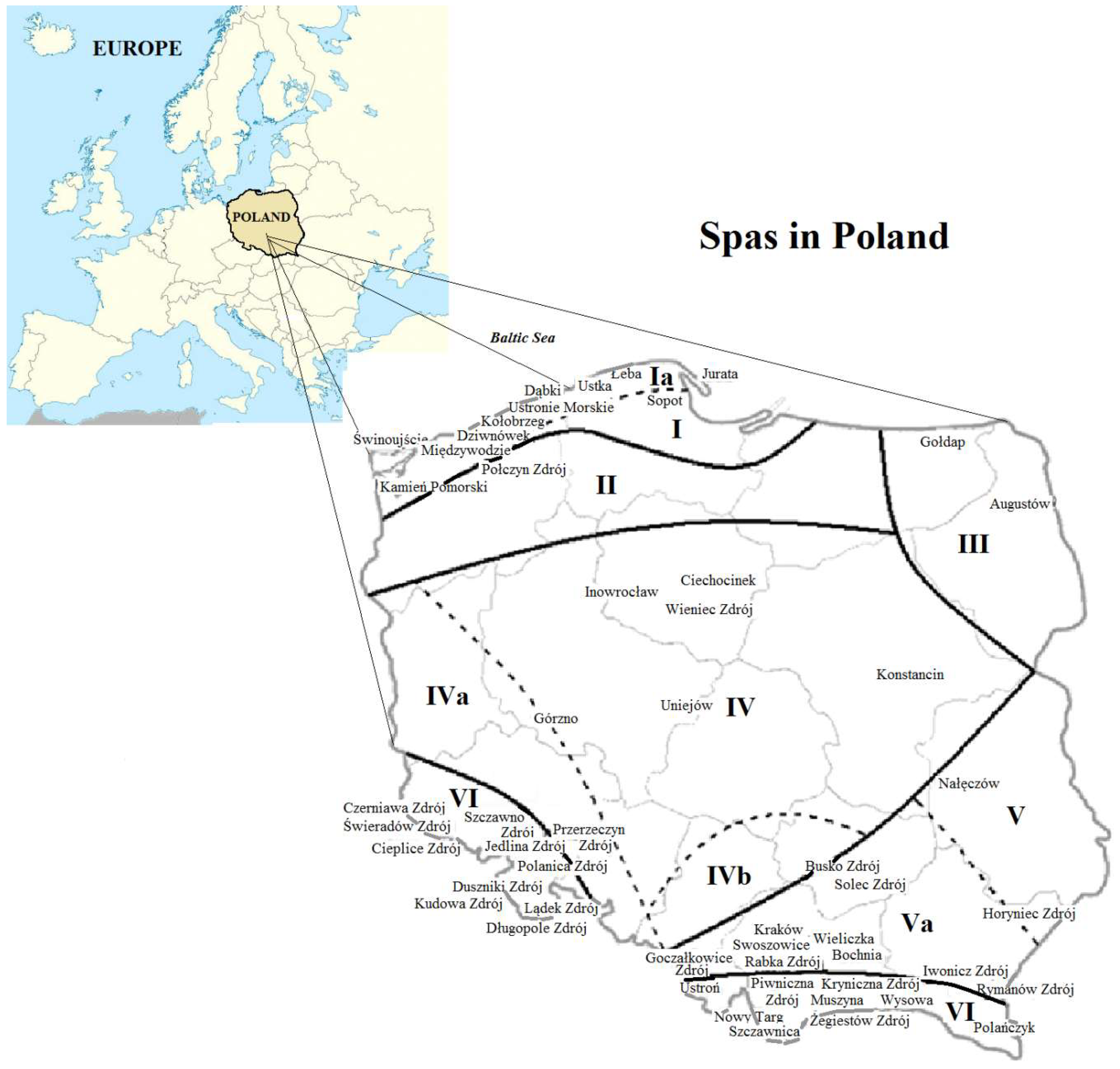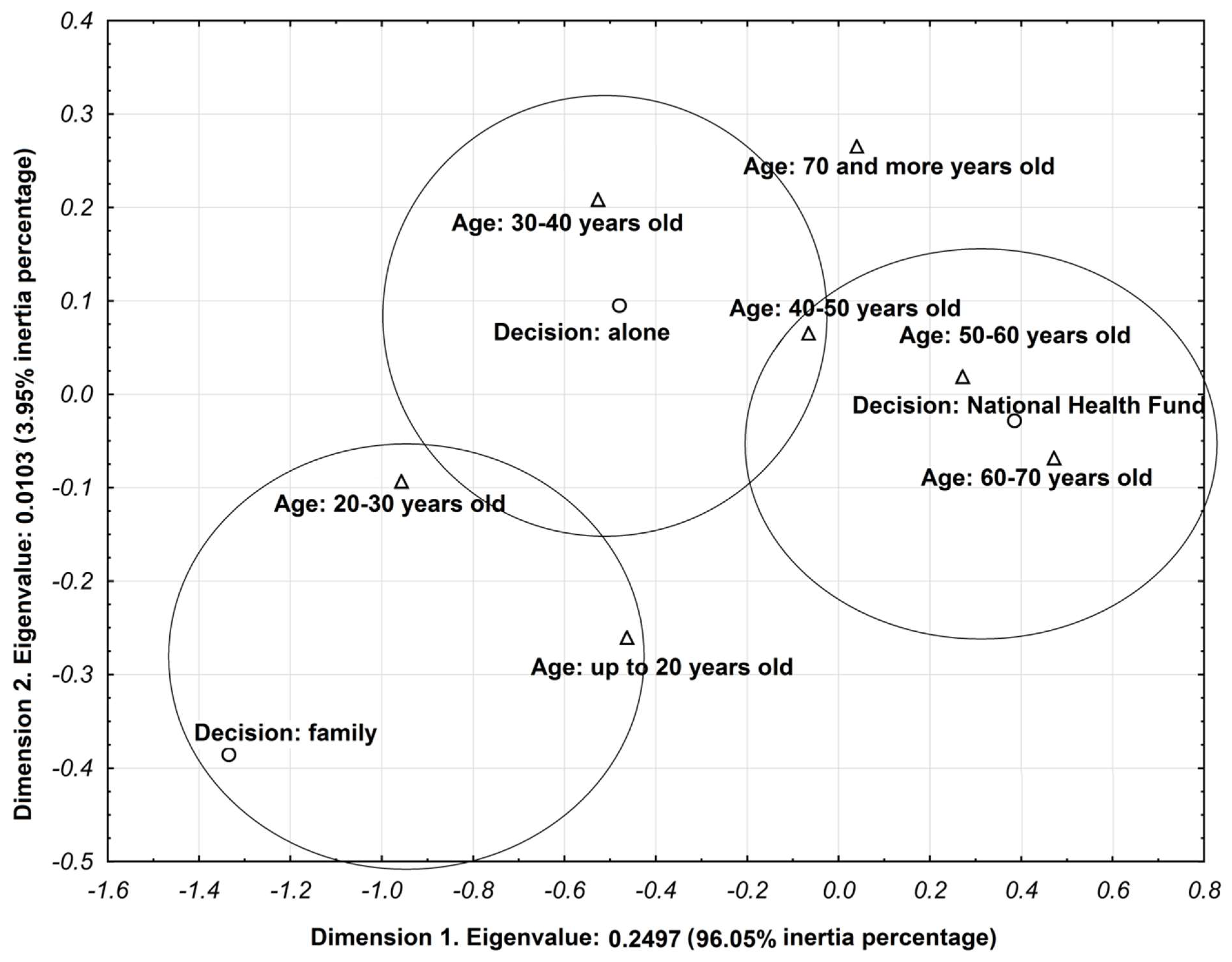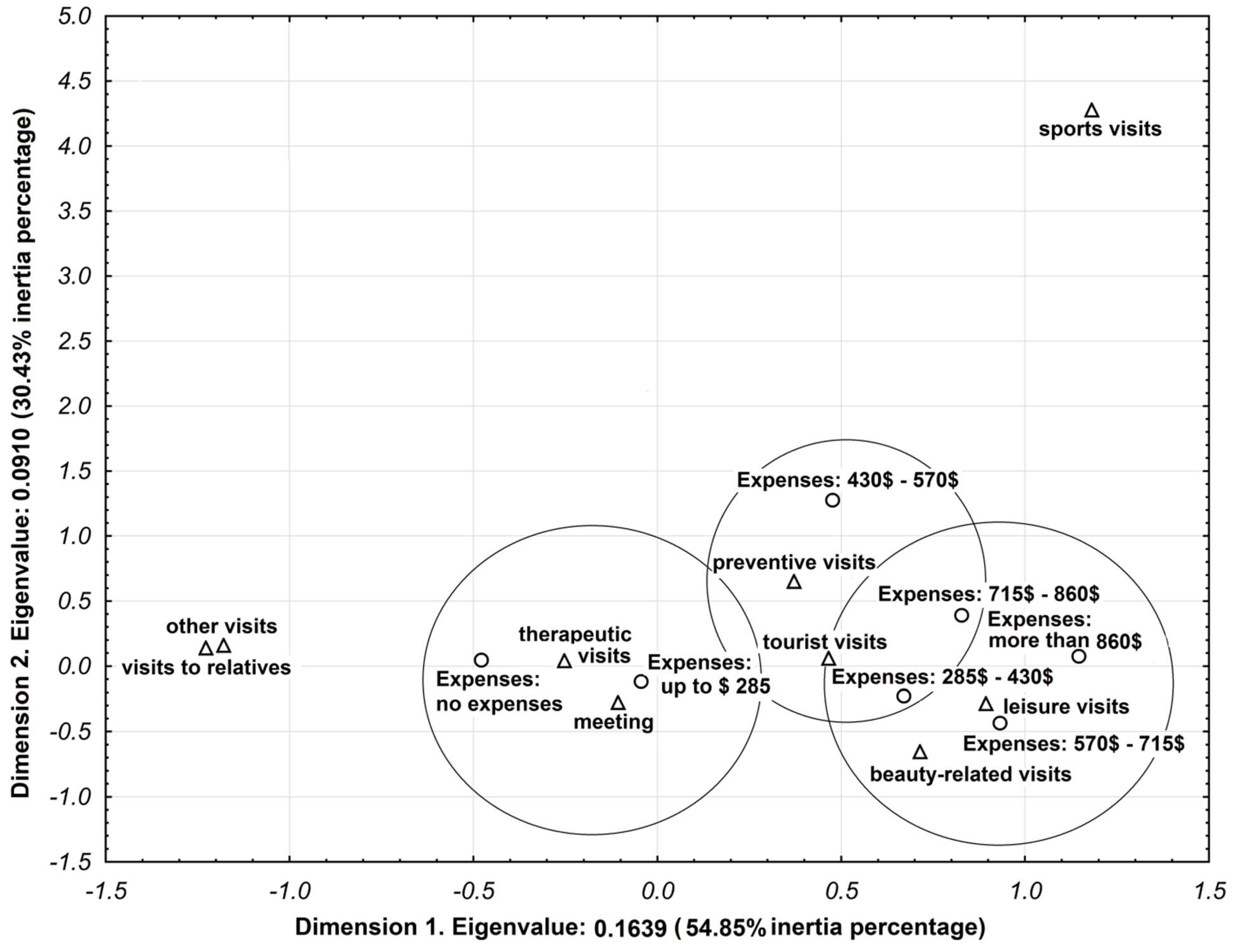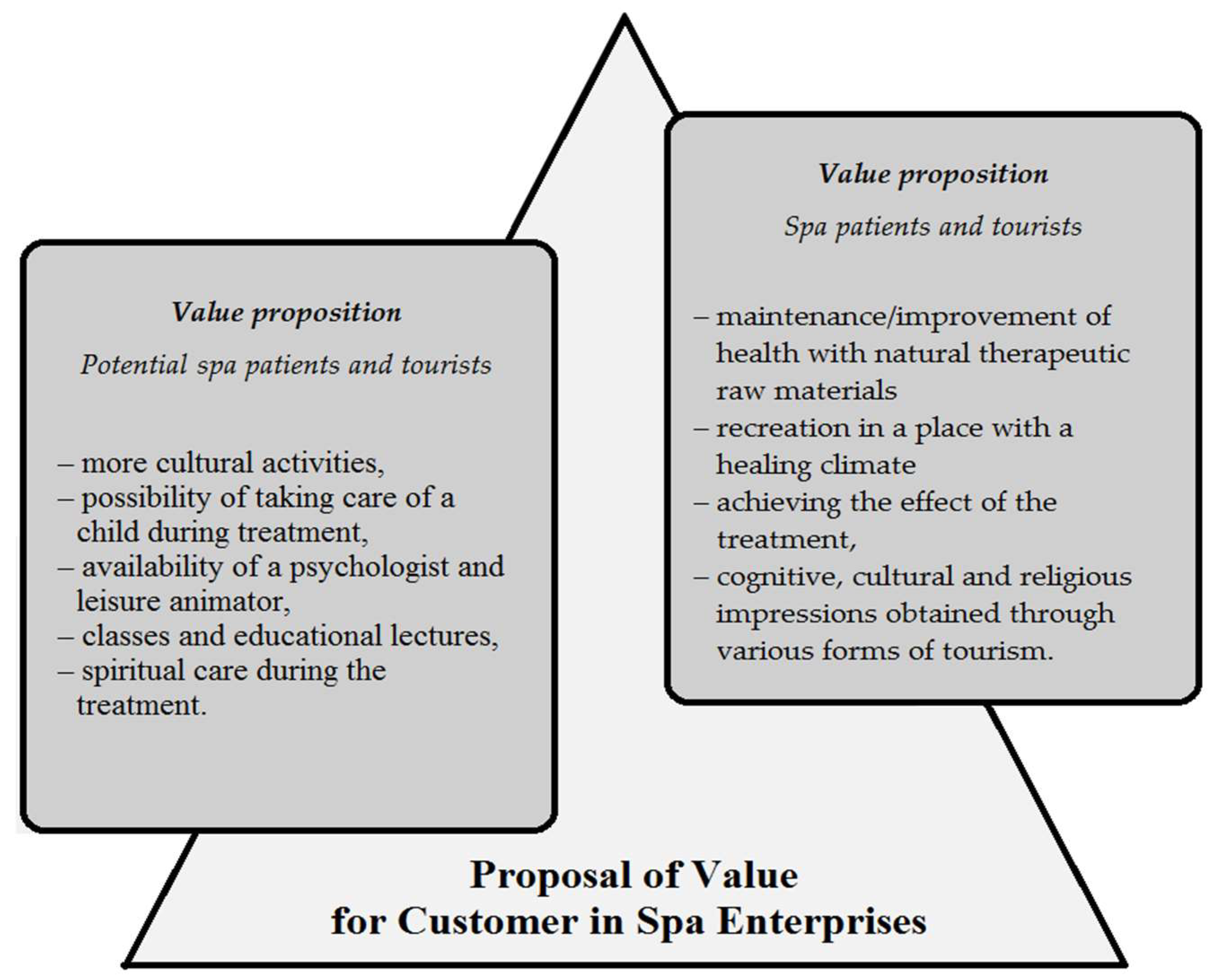Proposal of Value for Customer of Spas: Expectations of Spa Patients and Tourist in Polish Spas
Abstract
1. Introduction
2. Business of Health Tourism
2.1. Spa Tourism Enterprise
- The natural properties of therapeutic raw materials such as therapeutic waters, gases, and peloids (balneotherapy);
- The therapeutic properties of the climate (climate therapy), including thalassotherapy, subterrainotherapy, and microclimate.
2.2. A Reference to Sustainable Development
2.3. Business Model and Proposal of Values for Customer
3. Materials and Methods
4. Results and Discussion
5. Conclusion
- The improvement of health with natural therapeutic resources;
- recreation in a place with a healing climate;
- achieving the effect of the treatment (relaxation, beauty, improved beauty, weight loss, improvement of fitness, and sports results); and
- cognitive, cultural, and religious impressions obtained through various forms of tourism.
- The development of cultural activities,
- the possibility of taking care of a child during treatment,
- the introduction of a psychologist and leisure animator,
- the introduction of classes and educational lectures, and
- the introduction of spiritual care during the treatment.
Author Contributions
Funding
Acknowledgments
Conflicts of Interest
References
- Csirmaz, É.; Pető, K. International Trends in Recreational and Wellness Tourism. Procedia Econ. Financ. 2015, 32, 755–762. [Google Scholar] [CrossRef]
- Szromek, A.R.; Kapczyński, A. Hypotheses concerning the development of Polish spas in the years 1949–2006. Tour. Manag. 2008, 29, 1035–1037. [Google Scholar]
- McCarthy, J. Global spa & wellness trends. Psychology of Spas and Wellbeing. 2017. Available online: http://psychologyofwellbeing.com/201701/2017-global-spa-wellness-trends.html (accessed on 25 June 2019).
- Atanga Adongo, C.; Amuquandoh, F.E.; Amenumey, E.K. Modelling spa-goers’ choices of therapeutic activities. J. Hosp. Tour. Manag. 2017, 31, 105–113. [Google Scholar] [CrossRef]
- Loureiro, S.M.C.; Almeida, M.; Rita, P. The effect of atmospheric cues and involvement on pleasure and relaxation: The spa hotel context. Int. J. Hosp. Manag. 2013, 35, 35–43. [Google Scholar] [CrossRef]
- Szromek, A.R.; Naramski, M. A Business Model in Spa Tourism Enterprises: Case Study from Poland. Sustainable Tourism—Ways to Counteract the Negative Effects of Overtourism at Tourist Attractions and Destinations. Sustainability 2019, 11, 2880. [Google Scholar] [CrossRef]
- Information on Polish Spas. Ministry of Health of the Republic of Poland. Available online: http://www2.mz.gov.pl/wwwmz/index?mr=m8&ms=0&ml=pl&mi=625&mx=0&ma=10282 (accessed on 26 June 2019).
- Ajrapetova, N.S.; Uyanaeva, A.I.; Tupitsyna, Y.Y.; Antonovich, I.V. The role of climatic therapy in the combined spa and health resort-based treatment of the patients presenting with nonspecific respiratory diseases. Vopr Kurortol Fizioter Lech Fiz Kult 2016, 93, 43–51. [Google Scholar] [CrossRef] [PubMed][Green Version]
- Tomala, M. Ochrona środowiska regionu morza Bałtyckiego. Stud. Humanist. Społecz. 2011, 5, 67–81. [Google Scholar]
- Kozłowska-Szczesna, T. Bioklimat polskich uzdrowisk. In Uzdrowiska polskie: Informator; Madeyski, A., Ed.; Izba Gospodarcza Uzdrowiska polskie: Warszawa, Poland, 1999; p. 20. [Google Scholar]
- Dryglas, D. Kształtowanie Produktu Turystycznego Uzdrowisk W Polsce; Wyd. UJ: Kraków, Polen, 2006; pp. 118–120. [Google Scholar]
- Kozłowska-Szczesna, T.; Błażejczyk, K.; Krawczyk, B.; Limanówka, D. Bioklimat Uzdrowisk Polskich I Możliwości Jego Wykorzystania W Lecznictwie; PAN: Warszawa, Polen, 2002; p. 12. [Google Scholar]
- Ponikowska, I. Lecznictwo Uzdrowiskowe. Poradnik Dla Chorych; Wyd. Branta: Bydgoszcz, Polen, 1996; p. 57. [Google Scholar]
- Weaver, D.; Lawton, L. Tourism Management; Wiley Australia Tourism Series; John Wiley & Sons Australia: Milton, QLD, Australia, 2006; p. 32. [Google Scholar]
- Goodrich, J.; Goodrich, G. Health-care Tourism: An Exploratory Study. Tour. Manag. 1987, 8, 217–222. [Google Scholar] [CrossRef]
- Bushell, R.; Sheldon, P.J. Wellness and Tourism—Mind, Body, Spirit, Place. Innovation and Tourism; Cognizant Communication Corporation: New York, NY, USA, 2009; p. 8. [Google Scholar]
- Lanz-Kaufmann, E.; Muller, H. Wellness Tourism: Market analysis of a special health tourism segment and implications for the hotel industry. J. Vacat. Mark. 2001, 7, 5–17. [Google Scholar]
- Pezzey, J.; Toman, M. The Economics of Sustainability: A Review of Journal Articles. 2002. Available online: https://media.rff.org/documents/RFF-DP-02-03.pdf (accessed on 29 June 2019).
- Pezzey, J. An Interdisciplinary Guide. Environ. Values 1992, 1, 321–362. [Google Scholar] [CrossRef]
- Jacobs, M. Sustainable Development, Capital Substitution and Economic Humility: A Response to Beckerman. Environ. Values 1995, 4, 57–68. [Google Scholar]
- Niezgoda, A. Problems of implementing sustainable tourism in Poland. Econ. Bus. Rev. 2004, 4, 30–42. [Google Scholar]
- Piontek, F. Kontrowersje I Dylematy Wokół Rozwoju Zrównoważonego I Trwałego. Ekonomia A Rozwój Zrównoważony; Wydawnictwo Ekonomia i Środowisko: Białystok, Polen, 2001; p. 18. [Google Scholar]
- Adamczyk, J. Nitkiewicz, T. Programowanie Zrównoważonego Rozwoju Przedsiębiorstw; PWE: Warszawa, Polen, 2007; p. 27. [Google Scholar]
- Kidd, C. The evolution of sustainability. J. Agric. Environ. Ethics 1992, 1, 1–26. [Google Scholar] [CrossRef]
- Svenson, G.; Wood, G.; Callaghan, M. A corporate model of sustainable business practices: An ethical perspective. J. World Bus. 2010, 45, 336–345. [Google Scholar] [CrossRef]
- Grudzewski, W.M.; Hejduk, I.K.; Sankowska, A.; Wańtuchowicz, M. Sustainability W Biznesie Czyli Przedsiębiorstwo Przyszłości, Zmiany Paradygmatów I Koncepcji Zarządzania; Wyd. Poltex: Warszawa, Polen, 2010; p. 27. [Google Scholar]
- Burchell, J. The Corporate Social Responsibility Reader; Routledge, Taylor & Francis Group: London, UK; New York, NY, USA, 2008; pp. 111–118. [Google Scholar]
- Jabłoński, A. Zrównoważony rozwój a zrównoważony biznes w budowie wartości przedsiębiorstw odpowiedzialnych społecznie. Zeszyty Naukowe Wyższej Szkoły Humanitas. Zarządzanie 2010, 2, 15–30. [Google Scholar]
- Valeriani, F.; Margarucci, L.M.; Romano Spica, V. Recreational Use of Spa Thermal Waters: Criticisms and Perspectives for Innovative Treatments. Int. J. Environ. Res. Public Health 2018, 15, 2675. [Google Scholar] [CrossRef] [PubMed]
- Paduano, S.; Valeriani, F.; Romano Spica, V.; Bargellini, A.; Borella, P.; Marchesi, I. Microbial biodiversity of thermal water and mud in an Italian spa by metagenomics: a pilot study. Water Sci. Technol. Water Supply 2018, 18, 1456–1465. [Google Scholar] [CrossRef]
- Valeriani, F.; Protano, C.; Gianfranceschi, G.; Leoni, E.; Galasso, V.; Mucci, N.; Vitali, M.; Romano Spica, V. Microflora Thermarum Atlas project: biodiversity in thermal spring waters and natural SPA pools. Water Sci. Technol. Water Supply 2018, 18, 1472–1483. [Google Scholar] [CrossRef]
- Bernetti, A.; Mangone, M.; Alviti, F.; Paolucci, T.; Attanasi, C.; Murgia, M.; Di Sante, L.; Agostini, F.; Vitale, M.; Paoloni, M. Spa therapy and rehabilitation of musculoskeletal pathologies: a proposal for best practice in Italy. Int. J. Biometeorol. 2019. [Google Scholar] [CrossRef]
- Konczal, E. Models are for Managers, not Mathematicians. J. Syst. Manag. 1975, 26, 12–15. [Google Scholar]
- Magretta, J. Why business models matter? Harv. Bus. Rev. 2002, 80, 86–92. [Google Scholar] [PubMed]
- Teece, D. Business models and dynamic capabilities. Long Range Plan. 2017, 51, 1–10. [Google Scholar] [CrossRef]
- Battistella, C.; Toni, A.; Zan, G.; Pessot, E. Cultivating business model agility through focused capabilities: Amultiple case study. J. Bus. Res. 2017, 73, 65–82. [Google Scholar] [CrossRef]
- Osterwaldera, A.; Pigneura, Y. Business Model Generation: A Handbook for Visionaries, Game Changers, and Challengers. Paperback; John Wiley and Sons: Hoboken, NJ, USA, 2010; p. 28. [Google Scholar]
- Slywotzky, A.J.; Morisson, D.J.; Andelman, B. Strefa Zysku; PWE: Warszawa, Polen, 2000. [Google Scholar]
- Porter, M. Competitive Advantage: Creating and Sustaining Superior Performance; Free Press: New York, NY, USA, 1985; p. 61. [Google Scholar]
- Kardas, M. Pojęcia I Typy Modeli Biznesu. In Zarządzanie, Organizacje I Organizowanie—Przegląd Perspektyw Teoretycznych; Klincewicz, K., Ed.; Wydawnictwo Naukowe Wydziału Zarządzania Uniwersytetu Warszawskiego: Warszawa, Poland, 2016; pp. 298–318. [Google Scholar]
- Obłój, K. Tworzywo Skutecznych Strategii; PWE: Warszawa, Poland, 2002; p. 135. [Google Scholar]
- Kabalska, A.; Kozarkiewicz, A. Konfiguracja wartości dla klienta w sektorze uzdrowiskowym w Polsce. Studia Ekonomiczne. Zeszyty Naukowe Uniwersytetu Ekonomicznego w Katowicach. 2016, 299, 137–147. [Google Scholar]
- Stabell, C.B.; Fjeldstad, Ø.D. Configuring Value for Competitive Advantage: On Chains, Shops and Networks. Strat. Manag. J. 1998, 19, 413–437. [Google Scholar] [CrossRef]
- Mittra, J.; Tait, J. Analysing Stratified Medicine Business Models and Value Systems: Innovation-Regulation Interactions. New Biotechnol. 2012, 29, 709–719. [Google Scholar] [CrossRef] [PubMed]
- Shank, J.K.; Govindarajan, V. Strategic Cost Management: The New Tool for Competitive Advantage; Schuster Inc.: New York, NY, USA, 1993; pp. 1–480. [Google Scholar]
- Hitt, M.A.; Ireland, R.D.; Hoskisson, R.E. Strategic Management: Competitiveness and Globalization; Thomson/South Western: Mason, OH, USA, 2007. [Google Scholar]
- Johnston, R.; Lawrence, P.R. Beyond Vertical Integration—The Rise of the Valueadding Partnership. In Markets, Hierarchies and Networks: The Coordination of Social Life; Thompson, G., Ed.; SAGE: Newcastle upon Tyne, UK, 1991; pp. 193–202. [Google Scholar]
- Barney, J.B. Firm Resources and Sustained Competitive Advantage. J. Manag. 1991, 1, 99–120. [Google Scholar] [CrossRef]
- Hamel, G.; Prahalad, C.K. The Core Competencies of the Corporation. Harv. Bus. Rev. 1990, 5–6, 1–16. [Google Scholar]
- Ambrosini, V.; Bowman, C.; Collier, N. Dynamic Capabilities: An Exploration of How Firms Renew Their Resource Base. Br. J. Manag. 2009, 20, S9–S24. [Google Scholar] [CrossRef]
- Greenacre, M.; Hastie, T. The Geometric Interpretation of Correspondence Analysis. J. Am. Stat. Assoc. 1987, 82, 437–447. [Google Scholar] [CrossRef]
- Kendall, M.G. Multivariete Analysis; Charles Griffin: London, UK, 1975; pp. 3–198. [Google Scholar]
- Stanisz, A. Biostatystyka; Wyd. Uniwersytetu Jagiellońskiego: Kraków, Polen, 2005; pp. 9–409. [Google Scholar]
- Stanisz, A. Przystępny Kurs Statystyki Z Zastosowaniem Statistica Pl Na Przykładach Z Medycyny. Tom 3. Analizy Wielowymiarowe; StatSoft: Kraków, Polen, 2007; pp. 5–425. [Google Scholar]
- Sobczyk, M. Statystyka; PWN: Warszawa, Polen, 1997; pp. 5–321. [Google Scholar]
- Ostasiewicz, S.; Rusnak, Z.; Siedlecka, U. Statystyka—Elementy Teorii I Zadania; Wyd. WAE: Wrocław, Polen, 1997; pp. 5–322. [Google Scholar]
- Dryglas, D.; Salamaga, M. Segmentation by push motives in health tourism destinations: A case study of Polish spa resorts. J. Destin. Mark. Manag. 2018, 9, 234–246. [Google Scholar] [CrossRef]
- Szromek, A.R. Propozycja wartości dla klienta przedsiębiorstwa uzdrowiskowego. Folia Turistica 2018, 47, 9–24. [Google Scholar] [CrossRef]





© 2019 by the authors. Licensee MDPI, Basel, Switzerland. This article is an open access article distributed under the terms and conditions of the Creative Commons Attribution (CC BY) license (http://creativecommons.org/licenses/by/4.0/).
Share and Cite
Szromek, A.R.; Wybrańczyk, K. Proposal of Value for Customer of Spas: Expectations of Spa Patients and Tourist in Polish Spas. Sustainability 2019, 11, 3598. https://doi.org/10.3390/su11133598
Szromek AR, Wybrańczyk K. Proposal of Value for Customer of Spas: Expectations of Spa Patients and Tourist in Polish Spas. Sustainability. 2019; 11(13):3598. https://doi.org/10.3390/su11133598
Chicago/Turabian StyleSzromek, Adam R., and Katarzyna Wybrańczyk. 2019. "Proposal of Value for Customer of Spas: Expectations of Spa Patients and Tourist in Polish Spas" Sustainability 11, no. 13: 3598. https://doi.org/10.3390/su11133598
APA StyleSzromek, A. R., & Wybrańczyk, K. (2019). Proposal of Value for Customer of Spas: Expectations of Spa Patients and Tourist in Polish Spas. Sustainability, 11(13), 3598. https://doi.org/10.3390/su11133598





